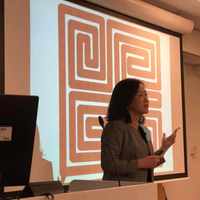Books by Erik Hammerstrom

In the early twentieth century, Chinese Buddhists sought to strengthen their tradition through pu... more In the early twentieth century, Chinese Buddhists sought to strengthen their tradition through publications, institution building, and initiatives aimed at raising the educational level of the monastic community. The Huayan University Network traces the influence of Huayan University, the first Buddhist monastic school founded after the fall of the imperial system in China. Although the university lasted only a few years, its graduates went on to establish a number of Huayan-centered educational programs throughout China. While they did not create a new sectarian Huayan movement, they did form a network unified by a common educational heritage that persists to the present day. Drawing on an extensive range of Buddhist texts and periodicals, Hammerstrom shows that Huayan had a significant impact on Chinese Buddhist thought and practice and that the history of Huayan complicates narratives of twentieth-century Buddhist modernization and revival. Offering a wide range of insights into the teaching and practice of Huayan in Republican China, this book sheds new light on an essential but often overlooked element of the East Asian Buddhist tradition.

Kexue, or science, captured the Chinese imagination in the early twentieth century, promising new... more Kexue, or science, captured the Chinese imagination in the early twentieth century, promising new knowledge about the world and a dynamic path to prosperity. Chinese Buddhists embraced scientific language and ideas to carve out a place for their religion within a rapidly modernizing society.
Examining dozens of previously unstudied writings from the Chinese Buddhist press, this book maps Buddhists' efforts to rethink their traditions through science in the initial decades of the twentieth century. Buddhists believed science offered an exciting, alternative route to knowledge grounded in empirical thought, much like their own. They encouraged young scholars to study subatomic and relativistic physics while still maintaining Buddhism's vital illumination of human nature and its crucial support of an ethical system rooted in radical egalitarianism. Showcasing the rich and progressive steps Chinese religious scholars took in adapting to science's rising authority, this volume offers a key perspective on how a major Eastern power transitioned to modernity in the twentieth century and how its intellectuals anticipated many of the ideas debated by scholars of science and Buddhism today.
Papers by Erik Hammerstrom

Critical Concepts and Methods for the Study of Chinese Religions II: Intellectual History of Key Concepts, edited by Stefania Travagnin and Gregory Adam Scott, pp. 121-134, 2020
It is widely recognized that of the many changes that occurred in Chinese culture and society dur... more It is widely recognized that of the many changes that occurred in Chinese culture and society during the twentieth century, the rapid ascent of modern science to a place of nearly unquestioned authority was one of the most important. One of the central goals of this volume is to critically assess the concepts we use in the study of modern Chinese religion, and we must take science into account as one such concept. I am certainly not the first person to suggest this, and a great deal of good scholarship has already been written on the role that the category of “science” has played in social, political, and legal movements in early twentieth-century China, especially vis-à-vis the categories of “religion” and “superstition.” Certainly, these are important issues, as such movements had a profound impact on the trajectories of Chinese religion throughout the twentieth century. Just as scholars have studied the popularity of science as an external force acting on religion, some have examined the way that scientific language has been employed by Buddhists, Daoists, and practitioners of qigong 氣功. My goal in this chapter is to expand upon these latter studies by analyzing in broad fashion some of the discursive uses to which religious actors in the Sinophone world have put scientific language and scientific ideas. We must acknowledge the ways in which they impact how religious people and religious bodies articulate their identities, both among themselves and to external groups.
Studies In Chinese Religions, 2017
Introduction to a special issue of Studies in Chinese Religion that presents some of the work tha... more Introduction to a special issue of Studies in Chinese Religion that presents some of the work that has been presented in the seminar ‘Revisiting the Revival: Holmes Welch and the Study of Buddhism in Twentieth-Century China,’ hosted
by the American Academy of Religion at its annual meetings from 2014 to 2018. This seminar aims to bring together scholars of modern Chinese Buddhism to critically assess the impact of Holmes Welch (1924–1981) on our field. The focus of the seminar and this special issue is the history of Chinese Buddhism during the latter part of the nineteenth and the first
half of the twentieth century.
Journal of Global Buddhism, 2016
This article describes the important but overlooked influence of Avataṃsaka thought within East A... more This article describes the important but overlooked influence of Avataṃsaka thought within East Asian Buddhism from the nineteenth century to the 1930s. It shows that Avataṃsaka was transnational in two significant ways: First, its popularity is illustrative of the connections that existed between Buddhists in China, Japan, and Korea during that time. Second, Avataṃsaka thought served as the basis for discourses of transnationalism.

Recovering Buddhist China in the Twentieth-Century, 2016
This book chapter examines the ways that Chinese Buddhists adopted and assented to an episteme as... more This book chapter examines the ways that Chinese Buddhists adopted and assented to an episteme associated with science in the early twentieth century. Buddhist intellectuals disseminated modern taxonomies of knowledge related to specific sciences, while also resisting and redefining the categories of science and religion themselves. In highlighting the ways in which modern classifications of knowledge affected these Buddhists’ discussions of their own tradition, this chapter reveals their contributions to the Science and Philosophy of Life Debates of the 1920s—, an important cultural moment in China in which the potential and limits of these new categories were discussed in an explicit manner.
This is a chapter in _Recovering Buddhist China in the Twentieth-Century_, edited by Jan Kiely and J. Brooks Jessup (New York: Columbia University Press, Sheng Yen Series in Chinese Buddhist Studies, 2016), 79-110.

Journal of Chinese Buddhist Studies, Jul 2014
This article introduces and translates “The Basic Problematic of Science” (Kexue zhi genben wenti... more This article introduces and translates “The Basic Problematic of Science” (Kexue zhi genben wenti), a short essay published in 1926 by the scientist and lay Buddhist Wang Xiaoxu (1875-1948). Although he did not use the term, the target of Wang’s essay was scientism, an extreme form of logical positivism which claims that natural science is the sole authority for answering questions of both fact and value. This materialist position became popular in China from the late 1910s, and it posed a serious challenge to a wide variety of ontological and epistemological claims, including those made within Buddhist circles. While he did not oppose science in general, Wang believed the spread of scientism would lead to an increasingly violent and materialistic society. As a result, he critiqued the authority of its absolutist view by emphasizing the epistemic limits of the scientific method, and by rejecting its Cartesian dualism in favor of the Mahayana Buddhist position that “the myriad dharmas are consciousness-only” (wanfa weishi).

Nova Religio, Nov 2013
This article uses theory developed in the study of NRMs to analyze strategies of legitimation emp... more This article uses theory developed in the study of NRMs to analyze strategies of legitimation employed by the Chinese Buddhist Wang Xiangliu (1876-1937) as he sought to spread a new form of esoteric Buddhism in 1930s China. It discusses the specific historical and religious context in which Wang was operating in order to identify the particular tensions that existed between the new Heart-of-Mind Method and the dominant culture. This context resulted in the specific issues that Wang focused on in arguing for the legitimacy of this nascent tradition, which included: 1) claims in society that esoteric Buddhism is “superstitious;” 2) changing cultural and political attitudes toward Japan and Tibet, which were the sources of much esoteric teaching in circulation in China during that period; and 3) the religious demand that any esoteric lineage be based upon a legitimate, traditional lineage which had the potential to undermine apparently sui generis traditions like Wang’s.

Transforming Consciousness: Yogācāra Thought in Modern China, 2014
In this chapter I focus on the circle of students and teachers at the first modern Buddhist semin... more In this chapter I focus on the circle of students and teachers at the first modern Buddhist seminary, a seminary closely associated with Taixu 太虛 (1890–1947). This “Wuchang School” can be viewed as another major inheritor of the great
lay Buddhist Yang Wenhui’s 楊文會 (1837–1911) legacy in modern Chinese Buddhism. Indeed, the Wuchang School was arguably more successful in the long term than Ouyang Jingwu’s 歐陽竟無 (1871–1943) China Inner Learning Institute
(Zhina Neixue Yuan 支那內學院), which is discussed in other chapters of this volume. Whereas Ouyang’s students Lü Cheng 呂澂 (1896–1989) and Xiong Shili 熊十力 (1885–1968) are rightly famous for their contributions to modern discourses about Yogācāra, the Wuchang School exerted a lasting influence on the institutions and thought of modern Chinese Buddhism that should not be overlooked. For members of this school, Yogācāra served as an indispensable resource for understanding and critiquing the complexities of modern mind
science.

Journal of Chinese Religion, vol. 39, pp. 1-32, 2012
The goal of this paper is to begin a discussion of the ways in which one loose group in Chinese s... more The goal of this paper is to begin a discussion of the ways in which one loose group in Chinese society, Buddhists, dealt with the rhetoric of scientific rationalism that rose rapidly in prominence in the Chinese intellectual world during the first decades of the 20th century. I approach this topic by examining the life and works of Wang Xiaoxu (1875-1948),6 a lay Buddhist and one of China’s first great modern scientists, who made significant contributions to the development of Chinese Buddhist discourses about science and the relationship between Buddhism and science. This article is comprised of two interlocking parts, each of which contains an argument about the development of Wang’s type of Buddhist modernism. Here, I write about both the life and the works of Wang Xiaoxu, and each of these two aspects of the man tells us something about developments in religious discourse in the Republican period.
Theology and Science, vol. 10, no. 1, pp. 3-18, Feb 2012
This article examines how the rising popularity of science in China during the early twentieth ce... more This article examines how the rising popularity of science in China during the early twentieth century influenced Buddhists there to look to less commonly studied scriptures to find
ways to demonstrate the consonance of Buddhism and modern science. The case studied here concerns the ideas popularized by the monk Taixu as he constructed from canonical sources a ‘‘Buddhist microbiology’’ that fit with modern microbiology.

The translation and dissemination of modern science in China was one of the main projects of Chin... more The translation and dissemination of modern science in China was one of the main projects of Chinese modernity in the late 19th and early 20th centuries. Buddhists played an active role in the appropriation of science in China as they sought to relate their tradition to science in such a way that Buddhism would still have a place in the society of the modern Chinese state. In the course of these negotiations, Chinese Buddhists dealt with the most current advances in science; they discussed X-rays in the 1890s, the discovery that the Milky Way is not the only one in the universe in the 1920s, and they followed developments in the fields of Relativistic and quantum physics. Buddhists argued that while science was invaluable for the people of the world, scientific materialism was not. They cautioned about the ethical implications of certain aspects of science, such as the invention of new weapons and the theory of social Darwinism. In this dissertation, I show how Chinese Buddhists drew from their traditions of epistemology, psychology, and cosmology to highlight similarities between science and Buddhism, all while maintaining the superiority of Buddhism by identifying it as a “higher empiricism.” I trace the historical development of Chinese Buddhist discourses about something called “science,” by which I do not mean a body of knowledge or a set of practices, but an ideological entity that was identified by conflicting definitions and usages. I explicitly avoid the pitfalls inherent in adopting the popular “conflict thesis” for understanding the relationship between science and religion. I also avoid the opposite view, that of the “compatibility thesis,” which states that Buddhism is inherently compatible with science (especially when compared with Christianity). In analyzing the development of Buddhist discourses on science, I point out the areas of disagreements among them with regard to the proper use of science, as well as the extent to which Buddhists thought they could or should rely on science to prove the veracity of their doctrine. Finally, I reflect on the ways in which this study could expand and enhance the global study of the relationship between science and religion.
This article offers a preliminary examination of the ways in which Consciousness-Only thought was... more This article offers a preliminary examination of the ways in which Consciousness-Only thought was adapted to modern intellectual discourses in China from the 1910s to the 1940s. It begins by tracing the canonical origins of the phrase “the three realms are only mind, the myriad dharmas are only consciousness (sanjie wei xin, wanfa wei shi 三界唯心,萬法唯識).” It then looks at several examples of how this expression was used by Buddhist writers in the early 20th century. It is argued that Buddhists chose to use the doctrine of Consciousness-Only (weishi) as a Buddhist ontology in contradistinction to the idealism (weixin) and materialism (weiwu) of philosophy.

In this thesis I argue that in order to understand Daoist monasticism we must understand their da... more In this thesis I argue that in order to understand Daoist monasticism we must understand their daily liturgy. As one of the few practices shared by members of a religious order spread over a large geographical area, the liturgy represents the most basic set of views and practices its members shared. As chanted text, liturgy also represents textual doctrine 'in action,' by examining the contents of that liturgy we gain greater insight into the nature of Daoist monasticism. I begin by reviewing the history of the Daoist monastic school known as the Quanzhen. In the second chapter I examine the social and soteriological roles of liturgy according to the most dominant order of the Quanzhen, the Longmen, by relying on liturgical and normative texts. In the third chapter I analyze an influential Longmen liturgical manual. Finally, I compare the structure of Daoist liturgy with the daily liturgy of Chinese Buddhist monasteries. I also contrast the Daoist monastic liturgy with other forms of Daoist ritual in order to demonstrate the unique nature of Daoist monastic liturgy.
Teaching Documents by Erik Hammerstrom

This course is about Buddhism in East Asia and the adaptation of Buddhism in the United States. S... more This course is about Buddhism in East Asia and the adaptation of Buddhism in the United States. Students will focus their studies on two Buddhist paths to enlightenment: Zen and Pure Land. Different in emphasis, these are the two most prominent practices of Buddhism in East Asia, and they are well represented in Tacoma, the City of Destiny. In this class, students will first learn about the historical development of these two forms of Buddhist praxis in Asia. Following this, students will examine the history of immigration from Asia to the U.S., with an emphasis on immigration to the Puget Sound. We will also study the intersection of race and Buddhism in America today. The first and second sections of the course serve as the groundwork for the third, in which students will study the history and current situations of several traditions present in our area: Korean Sǒn (Zen), Japanese Jōdō Shinshū (True Pure Land), and Vietnamese syncretic Buddhism. We will do this by learning from our neighbors as we make visits to several Buddhist communities located here in Tacoma. Through interactions with local Buddhists, students will learn about the ways in which the Buddhist faith has taken root in our city.
30-11:30, and by appointment Office: Hauge Admin 222 F (253) 535-7225 hammerej@plu.edu (My usual ... more 30-11:30, and by appointment Office: Hauge Admin 222 F (253) 535-7225 hammerej@plu.edu (My usual e-mail hours will be 8am-7pm, M-Sa)

This is not a course about Asian religions. This is a course on the history of Western perception... more This is not a course about Asian religions. This is a course on the history of Western perceptions of Asian religions. Students in this course will examine the history of two claims: The first is that Asian religion, and possibly even Asian culture, is inherently more "spiritual" than Western religion and culture. The second claim is that Asian religions such as Buddhism, Daoism and Hinduism are somehow all the same, that there really is only one Asian or "Eastern" religion. It is common to hear both of these ideas when talking about Asian religions in the West, and in this class we will critically examine some of the different trends in Western intellectual history that led to the popularity of these ideas. As a result, much of this class will focus on the history of big ideas in the West. If you are interested in what the different beliefs and practices of various Asian religions actually are, there are many other courses on Asian religion offered here at PLU on a regular basis and you should feel free to take one of those instead.
Materials on the Web by Erik Hammerstrom
An online essay on modern East Asian Buddhist uses of Huayan 華嚴 thought to in discussions of equa... more An online essay on modern East Asian Buddhist uses of Huayan 華嚴 thought to in discussions of equality and diversity.











Uploads
Books by Erik Hammerstrom
Examining dozens of previously unstudied writings from the Chinese Buddhist press, this book maps Buddhists' efforts to rethink their traditions through science in the initial decades of the twentieth century. Buddhists believed science offered an exciting, alternative route to knowledge grounded in empirical thought, much like their own. They encouraged young scholars to study subatomic and relativistic physics while still maintaining Buddhism's vital illumination of human nature and its crucial support of an ethical system rooted in radical egalitarianism. Showcasing the rich and progressive steps Chinese religious scholars took in adapting to science's rising authority, this volume offers a key perspective on how a major Eastern power transitioned to modernity in the twentieth century and how its intellectuals anticipated many of the ideas debated by scholars of science and Buddhism today.
Papers by Erik Hammerstrom
This is a chapter in _Recovering Buddhist China in the Twentieth-Century_, edited by Jan Kiely and J. Brooks Jessup (New York: Columbia University Press, Sheng Yen Series in Chinese Buddhist Studies, 2016), 79-110.
lay Buddhist Yang Wenhui’s 楊文會 (1837–1911) legacy in modern Chinese Buddhism. Indeed, the Wuchang School was arguably more successful in the long term than Ouyang Jingwu’s 歐陽竟無 (1871–1943) China Inner Learning Institute
(Zhina Neixue Yuan 支那內學院), which is discussed in other chapters of this volume. Whereas Ouyang’s students Lü Cheng 呂澂 (1896–1989) and Xiong Shili 熊十力 (1885–1968) are rightly famous for their contributions to modern discourses about Yogācāra, the Wuchang School exerted a lasting influence on the institutions and thought of modern Chinese Buddhism that should not be overlooked. For members of this school, Yogācāra served as an indispensable resource for understanding and critiquing the complexities of modern mind
science.
ways to demonstrate the consonance of Buddhism and modern science. The case studied here concerns the ideas popularized by the monk Taixu as he constructed from canonical sources a ‘‘Buddhist microbiology’’ that fit with modern microbiology.
Teaching Documents by Erik Hammerstrom
Materials on the Web by Erik Hammerstrom
Examining dozens of previously unstudied writings from the Chinese Buddhist press, this book maps Buddhists' efforts to rethink their traditions through science in the initial decades of the twentieth century. Buddhists believed science offered an exciting, alternative route to knowledge grounded in empirical thought, much like their own. They encouraged young scholars to study subatomic and relativistic physics while still maintaining Buddhism's vital illumination of human nature and its crucial support of an ethical system rooted in radical egalitarianism. Showcasing the rich and progressive steps Chinese religious scholars took in adapting to science's rising authority, this volume offers a key perspective on how a major Eastern power transitioned to modernity in the twentieth century and how its intellectuals anticipated many of the ideas debated by scholars of science and Buddhism today.
This is a chapter in _Recovering Buddhist China in the Twentieth-Century_, edited by Jan Kiely and J. Brooks Jessup (New York: Columbia University Press, Sheng Yen Series in Chinese Buddhist Studies, 2016), 79-110.
lay Buddhist Yang Wenhui’s 楊文會 (1837–1911) legacy in modern Chinese Buddhism. Indeed, the Wuchang School was arguably more successful in the long term than Ouyang Jingwu’s 歐陽竟無 (1871–1943) China Inner Learning Institute
(Zhina Neixue Yuan 支那內學院), which is discussed in other chapters of this volume. Whereas Ouyang’s students Lü Cheng 呂澂 (1896–1989) and Xiong Shili 熊十力 (1885–1968) are rightly famous for their contributions to modern discourses about Yogācāra, the Wuchang School exerted a lasting influence on the institutions and thought of modern Chinese Buddhism that should not be overlooked. For members of this school, Yogācāra served as an indispensable resource for understanding and critiquing the complexities of modern mind
science.
ways to demonstrate the consonance of Buddhism and modern science. The case studied here concerns the ideas popularized by the monk Taixu as he constructed from canonical sources a ‘‘Buddhist microbiology’’ that fit with modern microbiology.
Time: 1:00:43